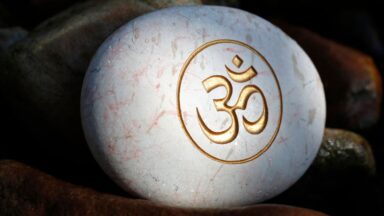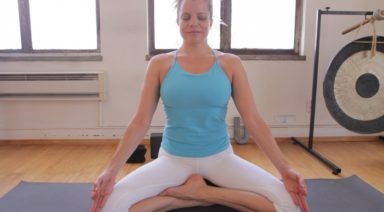Hanuman: Myth, Mantra and Asana

Hanuman was born on the wind and a prayer. His father was Kesari, a sort of meditating gladiator monkey-like humanoid, called in Sanskrit, a “vanara”. His mother, Anjana, held the essence of her name: “anj” in Sanskrit means reverence.
Anjana and Kesari really wanted a kid and prayed to Lord Shiva for the blessing of conceiving a son. Shiva, pleased by their devotion and prayers, sent Vayu, the god of wind, to carry Shiva’s essence to fulfill their wishes, perhaps something like a sacred stork.
Turns out that Vayu delivered a pretty gifted kid. Like his gladiator father and like many of our modern-day mixed martial art competitors, Hanuman had a plethora of skills and talents. He wrestled demons, transformed himself to fit the needs of the particular circumstances against which he was fighting, and did so all with unwavering devotion.
Hanuman was devoted to Lord Rama, the god of righteousness and virtue.
Through his devotion, he was characterized as a lifelong Brahmachari (celibate). The belief that Hanuman’s celibacy is the source of his strength became popular among the wrestlers in India.
Hanuman: Behind the Name
Sanskrit texts mention several stories about how Hanuman got his name. Hanuman had a lifelong obsession with the sun, and as a youngster, blazed towards it, mistaking the sun for a mango and mischievously chomping a bite out of it. This really pissed off Indra, the king of the gods, who struck Hanuman’s jaw with lightening, to scold his impetuous nature. A bit harsh, right? Regardless, Hanuman is said to have received his name from the Sanskrit words “hanu” meaning jaw, and “man” meaning prominent or disfigured.
Another lore credits the name as a derivative of the Sanskrit words “han” meaning killed or destroyed, and “mana” meaning pride; indicating that Hanuman is the one whose pride was destroyed.
As Saul David Raye shares in Earth Heart Hanuman, “humility comes when the jaw is broken.” Whether you’re an elite mixed martial artist, or simply a modern-day yogi maneuvering through daily challenges, we discover that when our hearts are full of devotion, our spirit is unbreakable. Saul David Raye says that the stories of Hanuman can teach us, “the balance of incredible opening while still staying balanced.”
It’s Hanuman we can thank for the devotion it takes to practice Sun Salutations, or Surya Namaskars, which are a series of poses linked by the breath. Sun Salutations invite us to bow to and unite with the sun, as a pathway to the divine.
Singing the Song of Hanuman
I never expected one of my fondest memories from my travels to India to be of a Hindi man and his love of a monkey. He was standing beside the 50-foot statue of Hanuman near Karol Bagh, New Delhi. “Do you know of Hanuman?” he asked, his excitement bubbling over like uncorked champagne.
I don’t think he introduced himself by name, as he proclaimed that, because of Hanuman, his elderly mother regained her health and his family was able to overcome losing their home. My neck hurt looking up at Hanuman in wonder. “Bring your troubles to Hanuman,” he said, looking directly at me, “and in return, you will receive blessings beyond belief.”
A while later, after returning home, I decided I wanted to learn to chant the Hanuman Chalisa, a Hindu hymn authored by Tulsidas, a 16th-century poet. Tulsidas wrote Hanuman Chalisa as an act of his devotion, and it’s said to continue to serve by keeping devotees’ minds free from evil.
My desire may have been influenced by the devoted man we met at the Hanuman in India, or the promise to have a free mind, but I thought it was simply because it had my name in it. Come to find out Chalisa actually means forty. So there are 40 verses in a derivative of Sanskrit to learn.
As much as I love a good challenge, this began to feel next to impossible; which apparently is right up Hanuman’s alley. My 40-day plan to practice each of the verses evolved into 108 days. Rising a few hours before dawn (said to be the best time for such spiritual undertakings), here are my favorite verses:
Sankata te hanumnaa chhudavai
Mana karma vachana dhyana jo lavai
“Hanuman will release those from troubles who meditate upon him in their mind, actions and words.”
Durgama kaja jagata ke jete
Sugama anugraha tumhare tete
“All the difficult tasks in the world become easy if there is your grace.”
Leaping Lizards
Legend has it that Hanuman took a courageous leap, doing the splits over the ocean to rescue Sita, the beloved of Rama, to whom Hanuman was entirely devoted. Hanuman took one look at the span across which he had to cross, thinking something along the lines of, “there’s no way I can do that!” Who hasn’t thought that same thing when faced with a monumental challenge du jour?
The pose associated with Hanuman is the splits. Often called ‘the leap of grace’.
I don’t know about you but my first attempts at doing the splits (aside from when I was five) were anything but graceful. Blessed with inflexible hamstrings and hips, practicing the splits has been a lengthy endeavor. It’s vital of course, to properly prepare by warming up the entire body, with particular attention to the backside of the legs, and hips.
Hanumanasana is often taught using one block at various heights to support beneath the forward extended hamstring. I’ve found that using two blocks underneath the hands (with stacked joints so wrists are in one line with elbows and shoulders) is more useful in progressing in depth over time in the asana.
The two-block method also provides additional support to lengthen the spine and extend the heart upwards. Getting out of the pose? Now that’s awkward. I’ve heard it said that on the other side of awkward, it is awesome.
It’s these moments in which we have the greatest opportunity to call upon whatever source of spiritual strength aids us. Hanuman exemplifies faith, trust, and being of service in such moments of doubt.
Hanuman Festival
Immerse yourself in a community of such devotion at the Hanuman Festival, every June, in Boulder, Colorado, a music-filled yoga festival at the foot of Colorado’s Rocky Mountains, with world-class yoga instructors. It’s an annual invitation to “immerse yourself in body, mind, and heart as you relax and rejuvenate, dance and devote, connect and expand, have fun and just be.”
Leap with Your Breath
Guiding students through Earth Heart Hanuman, Saul David Raye says, “When Hanuman leaps, he leaps with his breath.” In that way, Hanuman is an eternal entity in teaching us to find where the breath meets the body, where the body meets the bravery within our hearts, and enables our devotion to be a launching pad from which we meet life’s seemingly insurmountable challenges.
What Is the Om Mantra: Origin and Meaning

The mantra “Om” is much more than a simple syllable in yoga practice; it is an ancestral link with the universe and the divine. This article explores the secrets of this powerful mantra, delving into its origin, pronunciation, and meaning in yoga and spirituality.
Table of Contents
- Meaning of the Om Mantra
- What Is the Origin of the Om Mantra?
- How Is 'Om' Pronounced Correctly?
- What Does Om Mean in Yoga?
- Why Is Om Chanted in Yoga Classes?
- Benefits of Chanting the Om Mantra
- What Does the Om Symbol (ॐ) Represent?
Meaning of the Om Mantra
The Om mantra, symbolized by the sacred ॐ, is one of the most ancient and revered mantras in the spiritual traditions of India. It represents the essence of the universe, being a primordial sound that encapsulates truth and ultimate reality. In its vibration, Om encompasses everything that exists and everything that does not exist. This sacred sound is a synthesis of the spiritual and the material, symbolizing the union of the individual soul with the Divine, the Brahman, the ultimate reality.
More than just a syllable, Om is a symbol of connection and unity. In spiritual practices such as yoga and meditation, chanting Om helps align individual energies with those of the universe. Each repetition of Om is a reminder of our relationship with creation and a call for harmony and inner peace. It acts as a bridge between the material and spiritual worlds, facilitating the path to enlightenment and profound self-understanding.
What Is the Origin of the Om Mantra?
The origin of the Om mantra dates back to the ancient scriptures of India, such as the Vedas and the Upanishads, which are thousands of years old. In these texts, Om is presented as a cosmic sound, the original sound of the universe from which everything else emerged. This concept is found in various Dharmic philosophies and religions, such as Hinduism, Buddhism, and Jainism, where Om is considered the root of all spiritual knowledge.
In Hindu philosophy, Om represents the whole, the totality of existence, and is associated with the most important gods such as Brahma, Vishnu, and Shiva. In Buddhism, especially in tantric traditions, it holds great importance as part of longer mantras. This universality of Om underscores its significance in spiritual and philosophical practices, being a symbol of unity, peace, and spiritual knowledge throughout the ages.
How Is “Om” Pronounced Correctly?
Correct pronunciation of Om is essential for its effect and meaning. The syllable is pronounced “AUM” and consists of three sounds: A (ahh), U (ooh), and M (mmm). These three sounds symbolize different aspects of divinity and existence. The sound “A” represents the beginning, creation; “U” symbolizes preservation, and “M” represents transformation or destruction. When combined, these sounds represent the complete cycle of existence.
When pronouncing Om, the sound begins with an open and deep “A,” which starts in the throat and opens toward the chest. The sound transforms into “U,” moving toward the palate and vibrating in the middle of the mouth. Finally, the “M” closes the mantra, with a vibration that resonates in the front of the mouth and skull. This process not only has spiritual significance but also helps align and calm the mind and body, preparing them for meditation or yoga practice.
What Does Om Mean in Yoga?
In yoga, Om represents much more than a simple chanting or meditation practice. It is a symbol of profound connection between the practitioner and the universe. By chanting Om at the beginning or end of a yoga session, the goal is to harmonize the mind, body, and spirit with universal energies.
This sacred sound acts as a catalyst for mental tranquility and concentration, creating a space of serenity and focus for practice. Om in yoga not only prepares the body and mind for the session but also symbolizes the intention to unify the individual self with the cosmic whole, facilitating a deeper and more enriching experience.
Why Is Om Chanted in Yoga Classes?
Chanting Om in yoga classes serves several purposes. First, it creates a bond of connection and unity among participants, establishing a collective atmosphere of focus and serenity. Additionally, the vibrant sound of Om helps calm the mind and center attention, clearing mental and emotional noise.
Chanting Om is also considered beneficial for physical health, as the vibration generated can help relax muscles and calm the nervous system. This practice is not only a symbolic introduction or conclusion to the yoga session but also a powerful tool for deepening the spiritual and physical experience of yoga.
Benefits of Chanting the Om Mantra
Reciting the Om mantra has multiple benefits for both the mind and body:
- Reduces stress and anxiety: The vibration of Om induces relaxation, decreasing tension and mental restlessness.
- Improves concentration: The focus required to correctly chant Om helps enhance attention and mental clarity.
- Encourages spiritual connection: Repeating Om can intensify the feeling of spiritual connection and unity with the universe.
- Aligns body energy: The vibration of Om can help balance and align the chakras or energy centers in the body.
- Promotes respiratory health: Chanting Om involves conscious breath control, which can improve lung capacity and breathing.
What Does the Om Symbol (ॐ) Represent?
The Om symbol (ॐ) is a rich and complex visual representation of the Om sound. Each part of the symbol has a specific meaning: the lower curve symbolizes the waking state, the upper curve represents the deep sleep state, and the curve extending outward symbolizes the dream state. The crescent and dot at the top symbolize the transcendental state, a level of consciousness beyond conventional physical and mental states.
This symbol not only represents different states of consciousness but also the essential aspects of the universe: matter, soul, and God. The Om symbol is a visual reminder of the connection between the microcosm (the individual) and the macrocosm (the universe). In spiritual practice and daily life, the Om symbol serves as a constant reminder of our essential nature and our connection with everything that exists.
Whether through chanting or visual representation, Om is a timeless tool for those seeking harmony, balance, and a deeper connection with themselves and the universe.





































